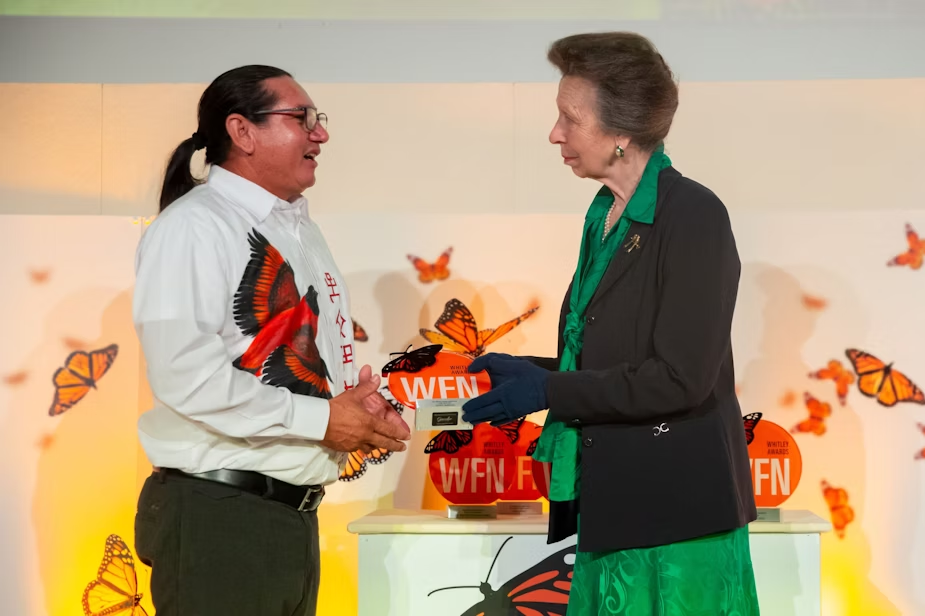GUYANA’S LEROY IGNACIO WINS 2024 WHITLEY AWARD TO EXPAND INDIGENOUS-LED CONSERVATION MOVEMENT TO PROTECT RED SISKIN
UK charity the Whitley Fund for Nature (WFN) recognises Leroy Ignacio from Guyana with a Whitley Award for galvanising one of the country’s first Indigenous-led conservation movements and to strengthen protection for the Red Siskin, a small Endangered finch which has become a flagship species for conservation in the rapidly developing rainforest nation.
Charity Patron, HRH The Princess Royal, presented the Whitley Award on 1 May at the Royal Geographical Society in a ceremony that marks three decades since the very first Whitley Award was presented and 25 years since the Princess’ involvement as Patron.
Guyana is navigating unprecedented change after a massive offshore oil discovery transformed it from one of South America’s poorest countries into the world’s fastest growing economy. President and founding member of the South Rupununi Conservation Society (SRCS), Leroy is leading an expansion of the community-managed conservation zone in southern Guyana, with his team of local rangers, to include the full range of the small songbird.
“This bird has created a movement in conservation in the Rupununi.”
Sir David Attenborough, WFN Ambassador and a long-term supporter of the charity, said the growing network of winners represent some of the best conservation leaders in the world: “Whitley Award winners combine knowing how to respond to crises yet also bring communities and wider audiences with them.”
Leroy, who is Indigenous Makushi, and his team are the primary agents for monitoring the Red Siskin for which they helped secure legal protection after it was “scientifically” discovered in Guyana in 2000 by Leroy and a group of friends from local Indigenous communities accompanied by international scientists. Leroy says that the Red Siskin was ‘scientifically’ discovered, as prior to this, local communities were already aware of the presence of the bird.
This inspired the creation of the 75,000 hectare Red Siskin Community Managed Conservation Zone to protect the bird in collaboration with five Indigenous communities. They designed the zone on their land in one of the first of its kind in Guyana, proving a model for other communities, and attracting eco-tourism to the remote area.
“Through winning the Whitley Award, we want to bring more recognition to indigenous people who assist international researchers and highlight their ability to lead their own research and conservation initiatives.”
One of South America’s smallest countries, rainforests cover more than 90 percent of Guyana’s landmass which store 19.5 gigatons of carbon, according to the country’s president. However, economic growth could threaten Guyana’s rich biodiversity and open up remote areas to development: Guyana’s discovery of some of the world’s most significant oil finds could see it produce as much oil as Nigeria by 2028.
The South Rupununi is a mixture of grassland savannahs and forests inhabited by the Indigenous people from the Wapichan, Makushi and Wai Wai who represent 57 communities. Most people live a subsistence lifestyle through farming, fishing, and hunting. Historically it has had low levels of deforestation.
The country is home to the only significant wild population of the Red Siskin after it was discovered to exist outside of Venezuela – where it was once common but numbers collapsed due to the wild bird trade. Historically called cardenalitos in Venezuela, its feathers were used to decorate hats and it was hunted to cross-breed with canaries to produce a red canary.
Leroy’s SRCS now plans to strengthen the monitoring, management, and sustainability of the zone amid threats to the bird which include trapping and habitat loss caused by wildfires. With his team of rangers – some of whom are now third generation – Leroy will bolster protection for the Red Siskin’s remote habitat from wildfires through active habitat management and controlled burning of areas at risk of wildfires around Red Siskin hotspots while working with communities and government to co-manage the site. Leroy’s team plans to lobby financial support for the active preservation of wildlife which extends to preserving species, including giant anteaters and giant armadillos.
Guyana is one of the world’s most vulnerable countries to climate change – at risk of droughts and floods. Nine in ten people live along the country’s coastline, which is two metres below sea level in some areas, according to the World Bank.

